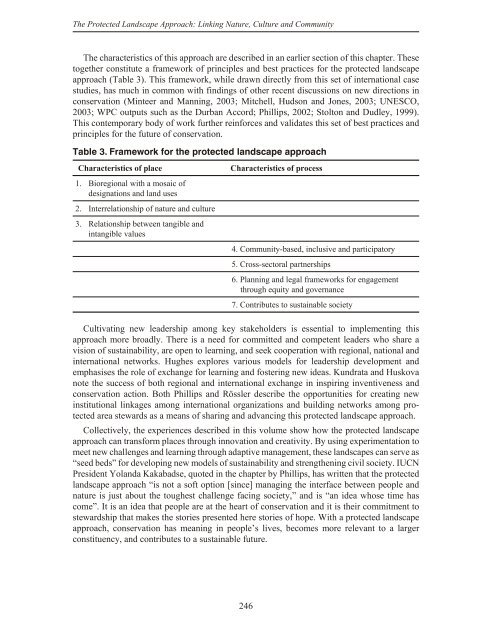The Protected Landscape Approach - Centre for Mediterranean ...
The Protected Landscape Approach - Centre for Mediterranean ...
The Protected Landscape Approach - Centre for Mediterranean ...
You also want an ePaper? Increase the reach of your titles
YUMPU automatically turns print PDFs into web optimized ePapers that Google loves.
<strong>The</strong> <strong>Protected</strong> <strong>Landscape</strong> <strong>Approach</strong>: Linking Nature, Culture and Community<br />
<strong>The</strong> characteristics of this approach are described in an earlier section of this chapter. <strong>The</strong>se<br />
together constitute a framework of principles and best practices <strong>for</strong> the protected landscape<br />
approach (Table 3). This framework, while drawn directly from this set of international case<br />
studies, has much in common with findings of other recent discussions on new directions in<br />
conservation (Minteer and Manning, 2003; Mitchell, Hudson and Jones, 2003; UNESCO,<br />
2003; WPC outputs such as the Durban Accord; Phillips, 2002; Stolton and Dudley, 1999).<br />
This contemporary body of work further rein<strong>for</strong>ces and validates this set of best practices and<br />
principles <strong>for</strong> the future of conservation.<br />
Table 3. Framework <strong>for</strong> the protected landscape approach<br />
Characteristics of place<br />
1. Bioregional with a mosaic of<br />
designations and land uses<br />
2. Interrelationship of nature and culture<br />
3. Relationship between tangible and<br />
intangible values<br />
Characteristics of process<br />
4. Community-based, inclusive and participatory<br />
5. Cross-sectoral partnerships<br />
6. Planning and legal frameworks <strong>for</strong> engagement<br />
through equity and governance<br />
7. Contributes to sustainable society<br />
Cultivating new leadership among key stakeholders is essential to implementing this<br />
approach more broadly. <strong>The</strong>re is a need <strong>for</strong> committed and competent leaders who share a<br />
vision of sustainability, are open to learning, and seek cooperation with regional, national and<br />
international networks. Hughes explores various models <strong>for</strong> leadership development and<br />
emphasises the role of exchange <strong>for</strong> learning and fostering new ideas. Kundrata and Huskova<br />
note the success of both regional and international exchange in inspiring inventiveness and<br />
conservation action. Both Phillips and Rössler describe the opportunities <strong>for</strong> creating new<br />
institutional linkages among international organizations and building networks among pro -<br />
tected area stewards as a means of sharing and advancing this protected landscape approach.<br />
Collectively, the experiences described in this volume show how the protected landscape<br />
approach can trans<strong>for</strong>m places through innovation and creativity. By using experimentation to<br />
meet new challenges and learning through adaptive management, these landscapes can serve as<br />
“seed beds” <strong>for</strong> developing new models of sustainability and strengthening civil society. IUCN<br />
President Yolanda Kakabadse, quoted in the chapter by Phillips, has written that the protected<br />
landscape approach “is not a soft option [since] managing the interface between people and<br />
nature is just about the toughest challenge facing society,” and is “an idea whose time has<br />
come”. It is an idea that people are at the heart of conservation and it is their commitment to<br />
stewardship that makes the stories presented here stories of hope. With a protected landscape<br />
approach, conservation has meaning in people’s lives, becomes more relevant to a larger<br />
constituency, and contributes to a sustainable future.<br />
246

















